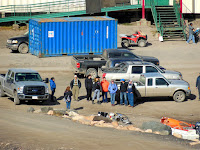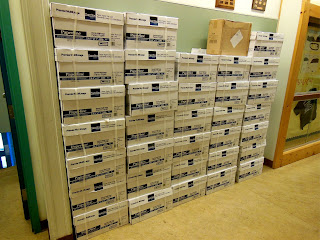 |
| Kiviuq I |
The
captain of the fishing vessel Kiviuq I extended a weekend lunch invitation to
the staff of Inuujaq School. The boat
had been hired by the Hunters & Trappers Organization (HTO) to fish, hunt,
and survey the waterways near Arctic Bay.
Over the course of two and a half weeks, the fishermen of the Kiviuq I
had caught shrimp, halibut, whelks, Greenlandic sharks, and muskox. The muskox were hunted on Devon Island. The lunch, followed by a tour of the vessel
took place on Saturday, August 29th. The
staff had to be split into two groups because the vessel could not accommodate
everyone at the same time.
It
was a quiet, clear-blue sky Saturday morning as I walked down to the bay,
dressed for the weather and armed with my digital camera and GoPro camera. I had taken a Gravol pill to combat any
potential sea sickness before leaving my residence. The boat was moored close to the shoreline
but a small boat would be used to transport us to the ship. I was the second staff member to arrive at
the pickup area in front of the Northern Store.
Greg, the Grade 5&6 teacher, had arrived first. After me came Jon, Jean-Francois (JF), Ryan,
Cindy, and two custodial staff. John
teaches Grades 7&8, JF teaches high school math & science, Ryan teaches
media & ESL, and Cindy is the school's District Education Authority
officer. We were the first group.
A
crew member from the Kiviuq I arrived in a small motorboat to transport us to
the ship. The ride took about two
minutes. A rope ladder was lowered down
to the motorboat so that we could climb aboard. I was the first one to climb the ladder. I was greeted by two fishermen who instructed
me to stand to the side so that the others could climb aboard. I took pictures of the middle deck while I
waited. The place was packed with ropes,
wooden traps, life jackets, and other supplies.
When everyone was aboard, we proceeded to the kitchen/mess cabin.
 |
| Jessie "The Cook" |
 |
| Condiments holder. |
Jessie
"The Cook" was there waiting for us.
He greeted us in a thick maritime province accent and invited us to sit
down. The kitchen/mess cabin is a small
room with two tables and seating for eight people. Each table had its own wooden condiments
holder. Two large signs informed
everyone that no smoking was allowed, and drugs & alcohol were not
permitted onboard. When the remaining
teachers arrived Jessie began serving us the lunch he prepared: beef stew,
freshly baked bread, coffee, tea, water, and juice. The food was excellent. We later learned that he would be preparing
most of the food for the community feast later that evening.
 |
| The captain speaks with JF. |
 |
| Me at the wheel. |
We were invited up to the bridge
after lunch. We got to speak to the
captain and take pictures of his workplace.
The captain is surrounded by a wall of monitors that feed him important
information while he navigates the boat.
The only item we were allowed to touch was the wheel. It's only there for historical decoration and
doesn't control the rudder. We all had
our photos taken while standing behind the wheel.
 |
| The Bridge |
The
captain decided to make our stay more enjoyable by taking us out into the
bay. As we sailed further away from the
community, one of the custodial staff women from the school got to pull the
cord that sounded the ship's horn.
Unfortunately, I happened to be out on the front deck and was not given
a warning. It was quite a sudden
surprise.
 |
| Locals camping at Uluksat Point. |
 |
| John & Ryan converse with the cliffs in the background. |
We
sailed past Uluksat Point and into the main waterway that connects to Admiralty
Inlet. The captain steered the boat
closer to the cliffs so that we could take pictures. John & JF were quite impressed by the
picturesque scenery. This was their
first time teaching in Arctic Bay.
 |
| Selfie Time! |
 |
| Sea Explorer I |
A
ship appeared on the horizon in the direction of Admiralty Inlet and was
sailing towards us. The captain steered
the boat closer to the cliffs to let the other vessel pass. The large vessel was the Sea Explorer I, a
cruise ship operated by Polar Latitudes, Poseidon Expeditions, and Quark Expeditions. The ship visited Arctic Bay around the same time last year and stayed for a day to let the tourists explore the town. I don't think any tourists came ashore this
time because the Sea Explorer didn't stay in the bay for very long.
 |
| Arctic Bay. |
 |
| The Second Group. |
The
captain navigated around the Sea Explorer I and brought us back to the
community. He had the anchor dropped not
far from the breakwater pier. I
photographed the second group of teachers waiting in front of the Northern
Store. The principal of Inuujaq School
was with them.
The
second group of teachers were picked up first and brought onboard. I filmed some them climbing up the rope
ladder. The first group of teachers said
their final goodbyes to the crew of the Kiviuq I and descended down the rope
ladder onto the small motorboat. We were
dropped off at the same place where we were picked up in the morning.
 |
| Bins of raw muskox & narwhal. |
I
made my way to the Community Hall at 6pm for the community feast. I came fully prepared: plastic bags, paper
plates, utensils, an ulu (knife), and several paper towels. The muskox meat was the main feature but the
crew of the Kiviuq I would also be serving cooked halibut, shrimp, whelks, and
raw narwhal. Unfortunately, the
Greenlandic sharks were not on the menu.
Two large and long Rona tarps were laid in the middle of the hall and a
line of five tables were set up at the front.
Behind them were nine plastic bins filled with raw muskox meat and two
with raw narwhal meat. I took a seat at
the back of the hall and waited for the feast to begin. I was later joined by Jon & JF. A group of volunteers emptied all the raw
muskox meat onto the tarps. They placed
the cooked halibut, shrimp, and raw whelks on the tables.
 |
| Whelks |
The
pre-feast show began once the hall was packed with people. There were speeches given by the mayor, the
HTO, and the captain of the Kiviuq I. The
captain and his crew were called to the front to be thanked by the community
for organizing the feast. Jessie
received additional praise for being the head chef. The crew received gifts for their efforts. The pre-feast show concluded with a
traditional drum dance performed by an elder and a prayer said by another
elder. When the prayer was done,
everyone rushed into the centre for free muskox meat.
 |
| Full house. |
 |
| Line up |
Both
of my hands were holding plastic bags as I rushed to get the best looking
muskox meat. There are no lines when the
raw meat is in the middle of the room.
It's a dash-and-grab. Just don't
be too pushy. I filled two plastic bags
with raw meat. I would be good for the
next month or so. The people who didn't
rush into the centre formed a long line in front of the tables serving hot
food. The line quickly stretched to the
back of the hall. Not wanting to stand
and wait for a very long time, I sat down and placed the smallest piece of
muskox on my paper plate. I took out my
ulu and began cutting it into pieces. I
didn't hesitate when I placed a piece of raw muskox into my mouth for the first
time.
 |
| Raw muskox meat. |
Raw
muskox meat has a milder taste than raw caribou meat in my opinion. I was glad that my stomach didn't have a
problem digesting it. As I continued to
eat without difficulty, I noticed John was looking at with a sense of wonder and
amusement.
"Why
bother waiting in line when you can eat the meat raw right away," I
commented.
"Yeah,
I guess," he replied with a chuckle.
I
offered him a small piece. He took it
with a hint of reluctance.
"It's
not bad. Trust me," I assured him.
John
ate the piece.
"See,
it's not bad."
"Yes,
you're right," he agreed with a nod, "but I'm going to stick to the
cooked food tonight."
"Of
course. It took me some time to get used
to eating raw meat."
 |
| Cooked halibut. |
JF
came over a little later and ate a small piece I offered to him. He liked it as well. I was asked by several local Inuit if I
enjoyed eating country meat to which I replied, "ii (yes). Mamaqtua (tastes delicious)". I later ate cooked halibut and shrimp after finishing the raw muskox meat.
Near
the end of the feast, the captain brought some his fishing cages & traps
inside and explained how they worked to the Inuit children.
 |
| The captain demonstrates how the fishing cages/traps work. |
I
quietly made my exit at the end of the feast and walked home with my bags
filled with muskox meat. A nice &
tasty way to finish the month of August.
The Kiviuq I left Arctic Bay the next day.
End of The Hectic Days of August
mini-series.







































